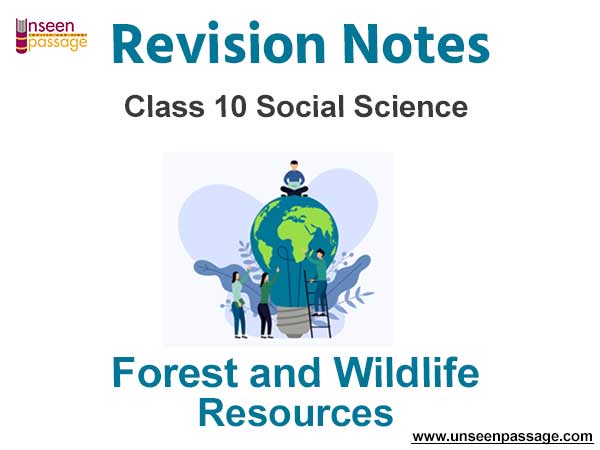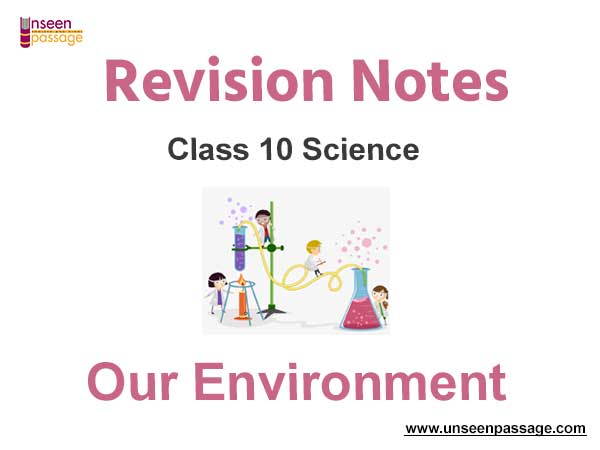Forest and Wildlife Resources Notes for Class 10 Social Science
Following are Forest and Wildlife Resources Notes for Class 10 Social Science. These revision notes have been prepared by expert teachers of Class 10 Social Science as per the latest NCERT, CBSE, KVS books released for the current academic year. Students should go through Chapter 2 Forest and Wildlife Resources concepts and notes as these will help you to revise all important topics and help you to score more marks. We have provided Class 10 Social Science notes for all chapters in your book. You can access it all free and download Pdf.
Chapter 2 Forest and Wildlife Resources Notes Class 10 Social Science
Key Points
1. Natural vegetation refers to aplant Community which has grown naturally. Forests (woodlands), geasslands etc. are it’s kind. It is also known as virgin vegetation.
2. Planted vegetation is planted and grown by human.
3. Wildlife : Wild animals living in the natural environment.
4. Domestic animals: Pet animals living and used by human.
5. Flora : Plants of a particular region or period.
6. Fauna : The species of animals.
7. Eco system : All the plants and animals in an area are inter-dependent and inter-related to each other in their physical environment, thus forming an ecosystem. Human being are also on integral part of the ecosystem.
8. Endemic Plants : The vergin (natural) vegetation, which are, purely Indian. They are also known as indigenous species.
9. Zoological (National) Parks : Reserved gardens for wild animals & birds.
10. Wildlife Sanctuaries : Natural forests where hunting and poaching of wild animal and birds are prohibited.
11. India is rich in it’s flora. It has about 47,000 plant species about 15,000 Flowering species are endemic (indigenous) to India.
12. India is also rich in it’s flora. It has more than 81000 of animal species. The country has more than 1200 species of birds. There are 2,500 species of fish, and more than 2500 species of insects.
13. Biodiversity or Biological Diversity means diverse form of plants and animals which are closely integrated and interdependent.
14. There are five types of forests in India. These are Tropical, Evergreen Tropical deciduous, Thorny, Montane and Mangrove.
15. Human beings cut the trees and kill the animals creating ecological imbalance.
16. “Project Tiger” one of the well publicised wildlife campaigns in the world, was launched in India in 1973.
17. The Indian wildlife (Protection) Act was implemented in 1972 and later in 1980, 1986 and 1991 some other provisions were added.
18. Community had played and can play a vital role in the conser-vation of forests and wild life in India.
19. The biological loss through destruction of forests and wildlife is strongly corrected with the loss of cultural diversity.
20. The greatest damage inflicted on India forests was during the colonial period.
Interesting Facts
1. Among the larges animals in India, 7a species of mammals, 44 of birds, 15 of reptiles, and 3 of amphibians are threatened.
2. Nearly 1500 plant species are considered endangered.
3. Asian Cheetah is nearly extinct due to a decline of available habitat and Prey.
4. ‘Taxol’ a chemical compound extracted from the Himalayan yew is the biggest selling anti-cancer drug in the world.
5. In some tribal areas Poverty is a direct outcome of environmental destruction.
6. American consumes no times more resources than an average somalian.
7. The Nicobar megapode is an endangered bird species.
8. If we share books after passing a class we may Save trees.
9. As per U. N. report per head trees in our country are 28 only While the number is 8953 in Canada, 4461 in Russia, 716 in U.S.A and 102 in China.
10. In every five years our Environment become hotter by 1 degrees Celsius.
Objective Type Questions
Question. Fill in the blanks
The term is used to denote plants of a particular region or period is ________ .
Answer
Flora
Question. Match the following –
| Community | Conservation |
| (i) The Mundas & santhal tribes. | i) T amarind and Mango |
| ii) Tribals of orissa & Bihar | ii) Beej Bachao |
| (iii) Bishnoi of Rajasthan | iii) Mahua and Kadamba |
| (iv) Farmers & citizen groups of Tehri | iv) Black buck (Chinkari) |
Ans.
| Community | Conservation |
| (i) The Mundas & santhal tribes. | (iii) Mahua and Kadamba |
| ii) Tribals of orissa & Bihar | (i) Tarmarind and Mango |
| (iii) Bishnoi of Rajasthan | (iv) Black buck (Chinkara) |
| (iv) Farmers & citizen groups of Tehri | (ii) Beej Bachao |
Question. Geographically correct the Statement –
Black buck is an extinct species in India.
Answer
Black buck is an endangered species in India.
Question. Choose the correct option –
What are amphibians ?
a) Animals that can live both on land and in water.
b) Animals that can live in water.
c) Animals that can live on the land.
d) none of the above.
Answer
a) Animals that can live both on land and in water.
Question. Write True (T) or False (F) at front of the following statements –
i) Shifting cultivation (jhum) is a type of ‘slash and burn’ agriculture. Which caused deforestation & degradation in India.
Answer
True
ii) Colonial teak monoculture has damaged the natural – forest in south India.
Answer
True
iii) Corbett National Park is situated in Kerala.
Answer
False
iv) Ultar Pradesh has the largest area under permanent forests.
Answer
False
v) The famous Chipko movement was successfully resisted deforestation in uttrakhand.
Answer
True
Very Short Answer Type Questions
Question. Name a bird, disappeared from Delhi in recent years?
Ans. Sparrow (cauriya)
Question. Name any one vulnerable species of animal in India ?
Ans. Asiatic elephant/gangetic dolphins/Blue Sheep etc.
Question. Which mineral mineral ore mining is causing a serious threat to the Buxa Tiger Reserve in West Bengal?
Ans. Dolomite (An ore)
Question. By which plant or tree the rich Himalayan oak was replaced during colonial period?
Ans. Chir Pine.
Question. Name the primary producers of the ecological system on which all other living beings depend?
Ans. Plants / Forests.
Question. Why Fuel – Fodder demand is partially responsible for depletion of forest resources?
Ans. As a substantial part of the fuel-fodder demand is met by lopping, rather than by felling entire trees.
Question. Write any one use of Forests and wildlife to us?
Ans. Wood, backs, leaves, rubber, medicines, dyes, food, fuel, Foddes, manure etc.
Question. How one can distinguish a cheetah from a leopard?
Ans. It’s distinguishing marks are the long teardrop shaped lines on each side of the nose from the corner of it’s eyes to it’s mouth.
Question. What is afforestation
Ans. Growing trees.
Question. Name a Medicinal plants found in India?
Ans. Jamun, Arjun, Neem, Babool, Tulsi, Kachnar etc.
Question. What is ecological imbalance?
Ans. A danger to the ecological system due to the loss of plants and animal species.
Question. Write any one cause to damage the Indian forests during colonial period?
Ans. Expanston of the railways / mining / agriculture / scientific forestry.
Question. What is IUCN ?
Ans. International Union for conservation of Nature and Natural Resources.
Question. Name the nearest rives to you place? why it is not clean?
Ans. River Yamuna, Due to pollution.
Question. What is deforestation?
Ans. Cutting trees.
Question. What is ecological system?
Ans. The complex Web made physical environment by the of inter relation and inter dependance of plants, animals and human beings.
Short/Long Answer Type Questions
Question. Which are the three type / categories of forest and wildlife resources classified by forest department? Explain.
Ans. (i) Reserved forests.
(ii) Protected forests.
(iii) Unclassed forests
Question. How do human beings influence the ecology of a region?
Ans. (i) They utilise the vegetation and wildlife.
(ii) The greed of human beings leads to overutilisation of these resources.
(iii) They cut trees and Kill animals, thereby creating an ecological imbalance.
(iv) As a result, some of the plants and animals have reached on the verge of extinction.
(v) Due to the insensitivity to our environment and lack of sustainable development.
Question. Suggest some ways that can put end to the indiscriminate destruction of our wild life ?
Ans. (i) Effective wild life Protection act by governments.
(ii) Indian Government have set up about four teen bioreserve to protect both flora and fauna.
(iii) Financial and Technical assistance is provided to many botanical gardens by the Government since 1992.
(iv) Project Tiger, project Rhino, Project Great Indian to Bustard and many other eco-developmental projects have been introduced.
(v) There are 89 National Parks, 490 wildlife Sanctuaries and Zoological Gardens set up.
(vi) Besides that all of us must realise the importance of the natural ecosystem for own survival.
Question. Which factors have led to the decline in India’s biodiversity Environmental destruction / degradation.
Ans. (i) Agricutwal Expansion after independence.
(ii) Over-Population
(iii) River Vally Projects
(vi) Mining
(v) Over Grazing & fuel wood collection
(vi) Un-equal access, inequitable consumption of resources.
(vii) Habitat destruction, hunting, poaching, over-exploitation, poisoning and forest fires.
(viii) Environment pollution.
Question. In which six categories we can classify the existing planks and animal species based on I.V.C.N, Explain.
Ans. (i) Normal Species
(ii) Endangered species
(iii) Vulnerable Species
(iv) Rare Species
(v) Endemic Species
(vi) Extinct species



